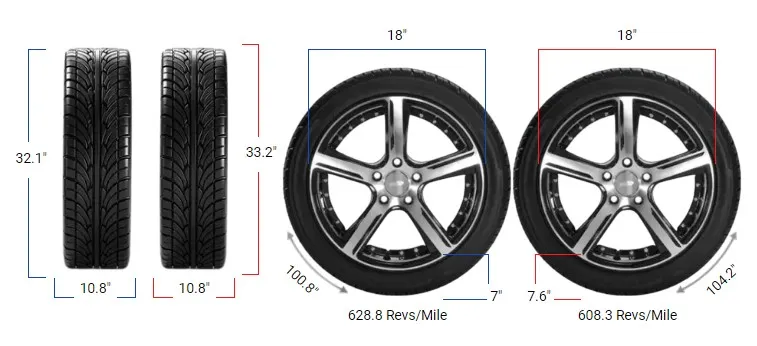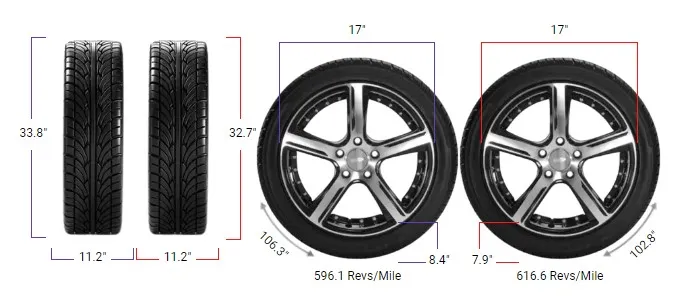165 vs 185 Tires

The main difference between 165 and 185 tires lies in their width. The 185 tires is about 20 mm wider than the 165 tires. A 165 tire is 165 millimeters wide, while a 185 tire is 185 millimeters wide.
This 20 mm difference in width can have a significant impact on how your vehicle performs in different driving situations.
The 185 tire offers a larger contact patch, which means more of the tire’s surface area is in contact with the road. This can lead to improved traction and stability, especially in dry conditions.
In contrast, the 165 tire has a narrower profile, which can provide advantages in fuel efficiency due to reduced rolling resistance.
This smaller contact area means there is less friction between the tire and the road, allowing the vehicle to move more efficiently and consume less fuel. However, it may also mean less grip in certain conditions, particularly during hard cornering or on wet roads.
On-Road Impact
The choice between 165 and 185 tires can also affect your on-road driving experience in a number of ways:

- Handling & Stability: The 185 tire provides better handling, particularly during cornering. The larger contact patch means more rubber is touching the road, resulting in greater lateral grip and increased stability during high-speed maneuvers. This makes 185 tires a popular choice for drivers looking for better control, especially in dry conditions.
- Fuel Efficiency: 165 tires tend to offer better fuel efficiency due to their narrower width. With less rolling resistance, the engine has to work less to maintain speed, which can lead to noticeable savings in fuel consumption, particularly for drivers who do a lot of city driving or long highway commutes.
- Comfort: The 185 tire, with its wider contact area, tends to absorb road imperfections better, providing a smoother ride on rough or uneven surfaces. However, this can also result in increased road noise compared to 165 tires, which may be more noticeable depending on the type of roads you frequently drive on.

Off-Road Impact
If you take your vehicle off-road, the difference between 165 and 185 tires can also be quite noticeable:
- Traction on Loose Surfaces: The 185 tire provides better traction on loose surfaces like gravel, sand, or mud, due to the increased width and contact patch. This makes it more suitable for light off-roading where extra grip is needed to maintain stability.
- Precision and Maneuverability: On the other hand, the narrower 165 tire can be advantageous in certain off-road conditions where precision is key. For example, on rocky terrain or narrow trails, the 165 tire can provide better maneuverability and help the vehicle navigate tight spaces more effectively.
Speedometer and Odometer Differences
Switching from 165 to 185 tires may also impact your vehicle’s speedometer and odometer readings. The overall diameter of the tire can change depending on the specific sidewall height, which may lead to discrepancies in speed and distance calculations.
If the new tire size has a larger overall diameter, your speedometer might show a speed lower than your actual speed, and your odometer might under-report the distance traveled.
To avoid any inaccuracies, it may be necessary to recalibrate your speedometer if you switch to a tire size with a significantly different overall diameter.

Benefits and Shortcomings of Switching
Benefits of 185 Tires:
- Increased Traction: The wider contact patch provides better traction, especially in dry conditions, which can enhance both handling and braking performance.
- Improved Ride Comfort: The larger contact area helps in distributing the load more evenly, which can result in a smoother and more comfortable ride.
Drawbacks of 185 Tires:
- Reduced Fuel Efficiency: The wider tire creates more rolling resistance, which can lead to a decrease in fuel efficiency, especially noticeable during city driving.
- Potential Clearance Issues: Depending on your vehicle, the wider 185 tire may cause clearance issues, leading to rubbing against the suspension or wheel well.
Benefits of Staying with 165 Tires:
- Better Fuel Economy: The narrower 165 tire has less rolling resistance, which can improve fuel efficiency, making it a good choice for those who prioritize lower running costs.
- More Predictable Handling in Tight Spaces: The narrower profile makes for easier maneuvering, especially in tight urban environments where agility is crucial.
Drawbacks of 165 Tires:
- Less Traction and Grip: Compared to 185 tires, the 165 tire has a smaller contact patch, which can result in less traction, particularly during high-speed driving or in wet conditions.
- Reduced Comfort: The smaller contact area can mean a stiffer ride and potentially more impact from road imperfections.

Difference Between 165 and 185 Tires
The main difference between 165 and 185 tires is the width. 185 tires are 20mm wider than 165 tires, which can influence handling, stability, and overall vehicle performance.
Can I Use 165 Tires Instead of 185?
Yes, you can use 165 tires instead of 185 tires, as the ideal rim width range for 165 tires (5.0-5.5 inches) overlaps with the minimum rim width for 185 tires (5.5 inches).
Additionally, ensure that the new tires have the same aspect ratio and rim diameter as your current set. The overall diameter difference should not exceed 3% to avoid impacting speedometer readings and vehicle dynamics.
Can I Use 185 Tires Instead of 165?
Yes, you can use 185 tires instead of 165 tires. The ideal rim width range for 185 tires (6.0-6.5 inches) overlaps with the ideal range for 165 tires (5.0-5.5 inches), ensuring compatibility.
Nevertheless, consider that the replacement tires must match your current aspect ratio and rim diameter. Any overall diameter variation should remain within 3% to prevent issues with speedometer accuracy and vehicle handling.

Can You Put 165 Tires on 185 Rims?
Yes, you can put 165 tires on rims designed for 185 tires. The ideal rim width range for 185 tires (6.0-6.5 inches) overlaps with the ideal range for 165 tires (5.0-5.5 inches), ensuring a proper fitment.
Can You Put 185 Tires on 165 Rims?
It is possible to put 185 tires on rims designed for 165 tires, as the ideal rim width range for 165 tires (5.0-5.5 inches) overlaps with the minimum rim width for 185 tires (5.5 inches). However, using wider tires on narrower rims may affect handling and tire wear.
Our Observation
Based on our observations, the choice between 165 and 185 tires ultimately comes down to your driving priorities. If you value fuel efficiency, maneuverability, and cost-effectiveness, 165 tires are a great option.
However, if you want better traction, stability, and a smoother ride, especially on rougher roads, 185 tires are likely the better choice.
Before making a decision, it’s always wise to consult with a tire professional to ensure that your chosen size is compatible with your vehicle.



